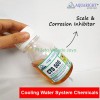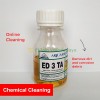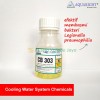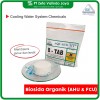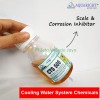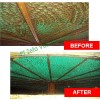Preventive Maintenance and Chiller Cleaning
MAINTENANCE AND CLEANING CHILLER
What is a Cooling System?
The vapor compression cooling system is the simplest and most commonly used cooling system. This system involves a working fluid that undergoes continuous processes of evaporation, condensation, compression, and expansion. The cooling system operates through the following four stages:
-
Compression Process
In this stage, the refrigerant in the form of saturated vapor with low pressure and low temperature is compressed by the compressor, increasing its pressure and temperature to levels higher than the ambient temperature. This process occurs isentropically, meaning the entropy remains constant.
-
Condensation Process
The high-pressure, high-temperature refrigerant vapor from the compressor enters the condenser. In the condenser, the refrigerant releases heat to the environment, causing its phase to change from vapor to saturated liquid. This process occurs isobarically, meaning the pressure remains constant.
-
Expansion Process
The saturated liquid refrigerant from the condenser enters the expansion device. Here, the pressure and temperature of the refrigerant are reduced, resulting in a mixture of vapor and liquid exiting the expansion device. This process occurs isoentropically, meaning the enthalpy remains constant as no heat is added or removed.
-
Evaporation Process
In this stage, the refrigerant, mainly in liquid form, absorbs heat from the room, causing its phase to change to saturated vapor. This process occurs isobarically (constant pressure) and isothermally (constant temperature).
Components of a Cooling System
A cooling system consists of four main components: the compressor, condenser, expansion device, and evaporator. These components work together synergistically to form an efficient refrigeration system.
-
Compressor
The compressor functions to compress the refrigerant and circulate it throughout the system. This compression process increases the pressure and temperature of the refrigerant, allowing the high-pressure, high-temperature refrigerant to flow through the system to the condenser.
-
Condenser
The condenser acts as a heat exchanger. In the condenser, the high-pressure, high-temperature refrigerant releases heat to the surrounding environment, changing its phase from vapor to liquid. This process reduces the refrigerant's temperature before it enters the expansion device.
-
Expansion Device (Thermal Expansion Valve - TXV)
The Thermal Expansion Valve (TXV) controls the flow of refrigerant to the evaporator in response to the cooling load. The TXV also measures the superheat at the outlet and adjusts the refrigerant flow to maintain a constant superheat level, ensuring efficient evaporator operation and preventing damage due to improper refrigerant flow.
-
Evaporator
The evaporator functions to absorb heat from the room. As the room air flows through the evaporator, the low-temperature refrigerant inside the evaporator absorbs heat from the air. This heat exchange process cools the air, which is then circulated back into the room, while the refrigerant evaporates and returns to the compressor to start the cooling cycle again.
Refrigerant R407
Refrigerant, often referred to as freon, is a fluid that absorbs heat at low temperatures and releases heat at high temperatures. This fundamental property makes refrigerants essential in cooling systems, enabling effective heat transfer between outdoor and indoor units.
Refrigerant R407 has two main variants:
1. R407a
R407a is a blend of hydrofluorocarbons (HFCs) used as a refrigerant. It is considered environmentally friendly as it does not deplete the ozone layer. R407a is commonly used in commercial and industrial cooling applications due to its efficient heat transfer capabilities.
2. R407c
R407c is a zeotropic blend of three HFCs: difluoromethane (R32), pentafluoroethane (R125), and 1,1,1,2-tetrafluoroethane (R134a). This blend is designed to replace the more environmentally harmful R22 refrigerant. R407c has thermodynamic properties similar to R22, making it suitable for air conditioning and heating applications. The zeotropic nature of this blend means that during evaporation and condensation, the individual components of the mixture evaporate and condense at different temperatures, which can affect system performance if not properly managed.
Both variants of R407 offer safer and more environmentally friendly solutions for various cooling applications while ensuring efficient and reliable performance.
Preventive Maintenance of Chiller Units
Preventive maintenance involves regular maintenance and care to prevent unexpected failures and to identify conditions that could cause equipment damage during operation. Through preventive maintenance, all production or processing facilities are ensured smooth operation and are kept ready for use at all times.
Preventive maintenance is crucial for handling production or processing facilities classified as critical units. A facility is considered critical if:
- Equipment failure poses health and safety risks.
- Equipment failure affects product or process quality.
- Equipment failure causes production or processing delays.
Cleaning and Maintenance Steps for Chiller Units
1. Cleaning Fan Coil Condenser
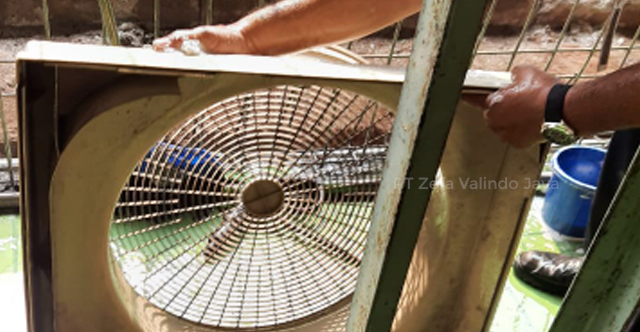
Over time, dirt and debris are sucked into the outdoor condensing unit and start to coat the condenser coils. This makes it difficult for the condenser coils to perform their task, as it becomes harder to transfer heat to the outside air when the coils are covered with dirt. Without regular cleaning, the chiller will use more energy while decreasing its ability to reach the desired temperature, ultimately increasing costs and reducing performance.
Steps for cleaning fan and coil condensers:
- Remove the fan and condenser casing and place it in a safe location.
- Clean the fan and condenser coils using a jet spray, taking care not to damage the condenser fins.
- Clean the fan casing and chiller body, ensuring that electrical components are not exposed to water.
- Once cleaned, reassemble the fan and condenser casing to their original condition
2. Checking the Filter Drier
The filter drier is a component of the cooling system that filters out particulates and moisture from the refrigerant system. To check it, feel the pipes before and after the filter drier. If there is a temperature difference, the filter drier is likely clogged.
3. Ampere Checking 
The amperage check to determine whether the compressor load is not excessive or reduced. The checking step is by turning on the chiller unit which has been cleaned, then open the outdoor unit power supply cover, attach the ampere pliers to one of the power cables, check the amperage situation and match it with what is listed on the nameplate.
4. Checking Refrigerant Pressure
Checking the refrigerant pressure determines the refrigerant levels in the chiller system. Compare the pressure reading with the parameters on the chiller's nameplate to determine if the refrigerant level is sufficient.
5. Checking Oil Level, Sight Glass, Compressor Relay, and Compressor Heater
Checking the oil level to find out whether the oil in the compressor is sufficient and is still in good condition. A darker oil color indicates poor condition. Oil change is recommended every 2000 hours of operation. Sight glass is used to see the refrigerant flow in the system and analyze its phases. If the liquid flows, it means the refrigerant phase is liquid, and if there are bubbles it means there is a mixture of vapor and liquid.
6. Checking the Expansion Valve (Thermal Expansion Valve - TXV)
Detailed checking of the TXV involves removing it from the system, but generally, you can check by feeling the pipes before and after the TXV during operation. If the pipe after the TXV is cold and condensation forms, the TXV is functioning properly. The TXV is located between the condenser and the evaporator.
By following these steps, the chiller unit can operate efficiently and deliver optimal performance at all times. For chiller free survey please fill the form here.



